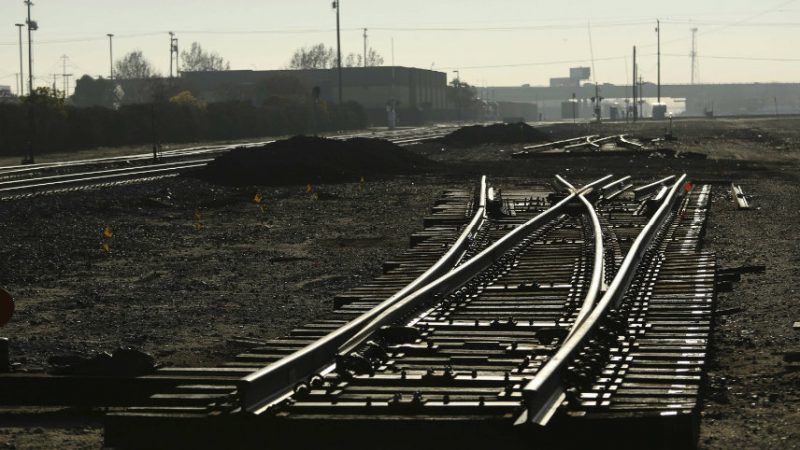Rail Transit Is a Dead End, but Social Planners Keep Pushing for More
Government planners do not understand markets, so they promote overly pricey projects that fail to meet our real-world transportation needs.

It has been around 15 years since Orange County tried to build a $1 billion light-rail system that would have gone from one suburban parking lot to another. It would have moved around half of 1 percent of the county's commuters. What I remember most about that incredibly shrinking Centerline was that while it was supposed to reduce congestion overall, it would actually have increased congestion along main thoroughfares.
That was my first up-close encounter with the Cult of Transit. There is nothing wrong with expanding bus service and building new rail lines—provided they actually enable people to get where they are going. However, urban planners' fixation on transit stems more from social engineering than transportation engineering. The latter develops projects that enable people to get from Point A to Point B. The former builds projects designed to change the public's behavior—prodding them into getting around in ways the planners believe is best.
If you've got time on your hands, peruse the details of virtually any road-funding bond measure and see how much of the new tax revenue goes to roads—and how much goes to bike lanes and other alternative transportation methods. I remember when Gov. Gray Davis was at a ribbon cutting for a stretch of the 210 freeway near San Bernardino. Commentators declared that after that opening, the era of road building was over. No wonder congestion has only gotten worse.
Despite the planning community's long-running embrace of transit, the latest data suggests the public prefers to get around in their cars and SUVs. Using statistics from the Federal Transit Administration, transportation expert Randal O'Toole summed up the data in The Hill: "Ridership declined in all of the nation's 38 largest urban areas. Transit systems in Austin, Boston, Charlotte, Cleveland, Miami, Milwaukee, Philadelphia, San Diego, and Tampa-St. Petersburg all suffered double-digit declines, with Austin losing 19.5 percent and Charlotte 15.4 percent despite being two of the fastest growing urban areas in the nation."
That's stunning given not only the $50 billion in subsidies that transit systems receive each year—but the Herculean attempts by urban planners to promote higher-density living through proscriptive land-use policies and tax subsidies, as O'Toole added. Transit systems work reasonably well in traditional cities such as New York and Chicago, but look at the design of California's metropolises. Commuting patterns go every which way, which makes it tough to develop an effective transit system to meet our needs.
Have you noticed how Californians move up and down the state?
They take Southwest Airlines, which offers low-cost, quick flights serving the major airports. Yet former Gov. Jerry Brown had focused his attention on building a $100-billion high-speed rail system that, if it ever is completed, will have ticket prices higher than airfares and will take nearly twice as long as flying to get from the Bay Area to Southern California. What is the point? The answer echoes my earlier point: Politicians and planners use public money to change how we live in pursuit of grandiose goals, such as slowing global warming. Easing cross-state travel is important, but if that were the primary goal, our leaders would consider a variety of practical—but boring—ideas, such as improving air service in hard-to-reach places such as Bakersfield, the Central Coast or Redding.
I think of my attempts to take transit to go from my exurb to downtown Sacramento. It would involve driving to a station 20 minutes away, paying for parking, buying a ticket and waiting for a train. It would take longer and cost almost as much as just driving downtown directly and parking. That train might make sense in the urban core, but not in the outlying areas, yet officials love to lecture us about our supposedly unsustainable reliance on driving.
This highlights the real problem with transit. Planners, not consumers, drive it. Real private enterprises—as opposed to firms receiving taxpayer-funded subsidies to build government-directed projects—would never build a rail system based on an "if we build it, they will come" model. They would build systems that meet customer needs rather than fulfill wishful fantasies.
Furthermore, O'Toole refers to our current approach as "big-box transit," which involves "moving people in 60-passenger buses, 450-passenger light-rail trains or 1,500-passenger heavy-rail or commuter-rail trains." This approach is the result of union pay scales and government's inefficient and centralized approach to transportation.
Opening up the marketplace could result in myriad, small-scale alternatives, similar to the way that Uber and Lyft have disrupted the taxi industry. Government planners only understand taxing and regulating and do not understand markets, so they promote overly pricey projects that fail to meet our real-world transportation needs. Until planners figure that out, expect those transit ridership numbers to keep falling.
This column was first published in the Orange County Register.
Steven Greenhut is Western region director for the R Street Institute. He was a Register editorial writer from 1998 to 2009. Write to him at sgreenhut@rstreet.org.


Show Comments (70)